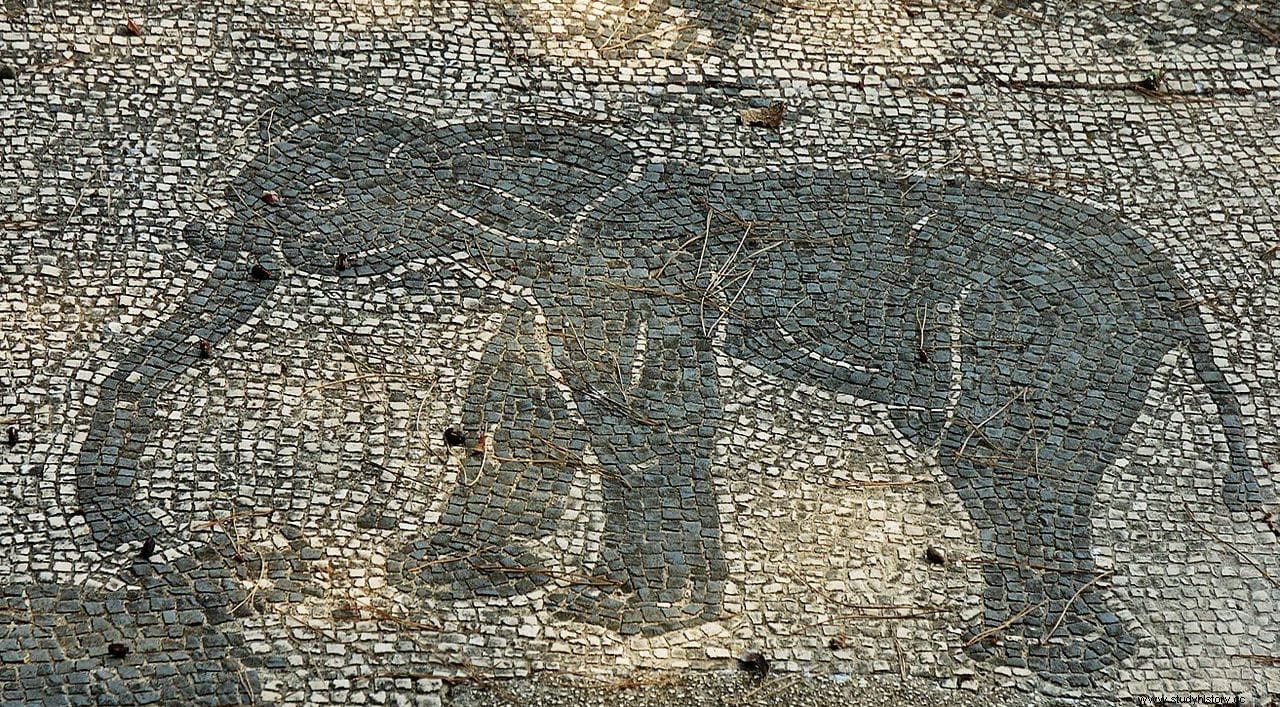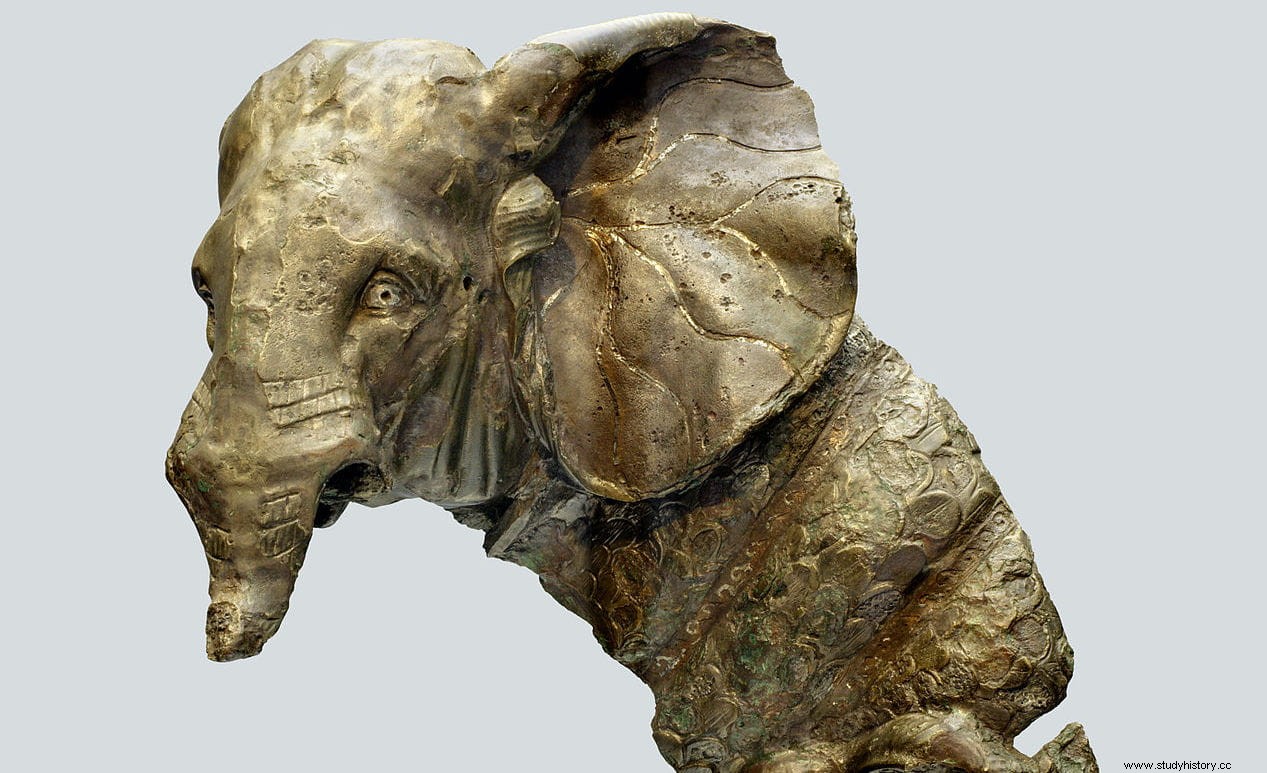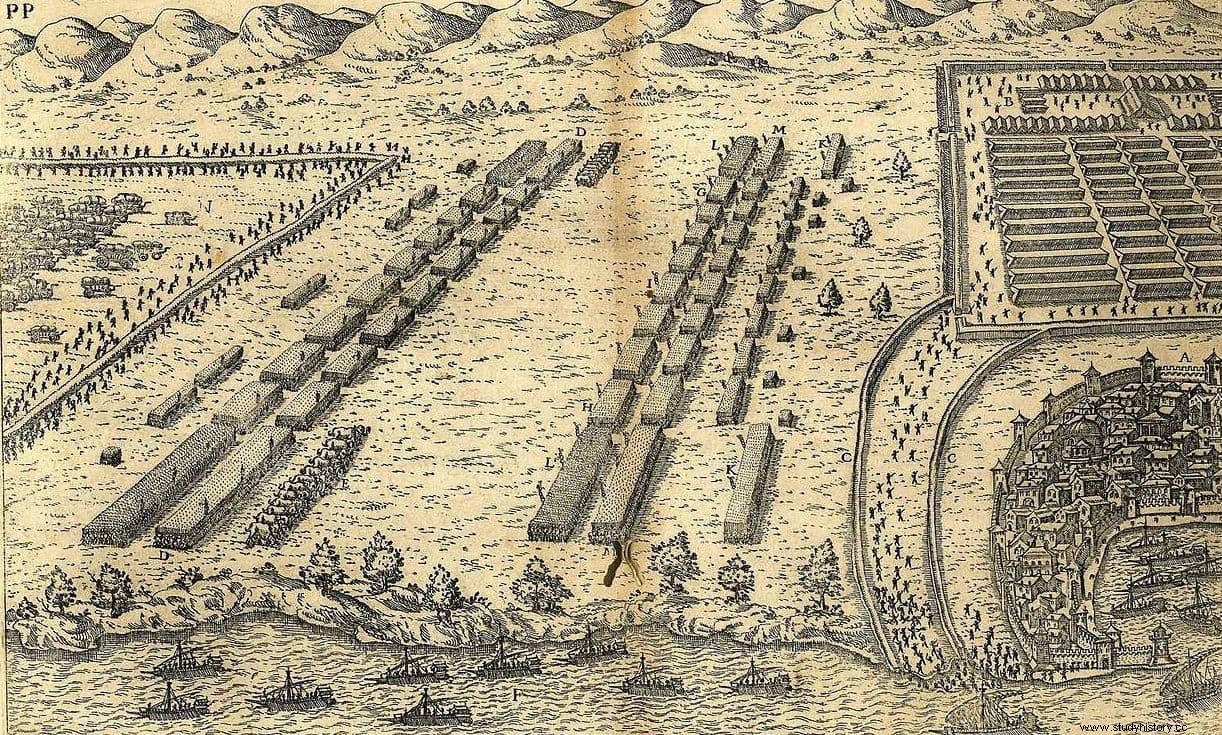Animals have accompanied Man in war practically since the domestication of the dog, constituting the combat vehicles of the time, apart from chariots, horses, camels and elephants. The latter can be considered the tanks of other times and we usually see them represented in illustrations and movies, although almost always in a wrong way:the first ones usually show them huge, the typical ones of the savannah with their big fangs and ears, while the movies have to use the smallest Indian elephant for its greater docility. The fact is that the famous pachyderms that Hannibal Barca took with him over the Alps did not belong to one type or the other but to a third species that is now extinct:the North African elephant or Loxodonta africana pharaonensis .
Elephantids are the largest land animals today. They belong to the order of the proboscideans, which in other times numbered three and a half hundred varieties, since they have existed since prehistory, but little by little they evolved and/or disappeared as they were unable to adapt to changes in their habitats. Thus, in ancient times there were only two genera left, Loxodonta and Elephas , the first in Africa and the second in Asia, divided into several species and subspecies. We are going to leave aside the Asians, of which only the Elephas maximus survives. with three subspecies (maximus maximus, maximus indicus and maximus Sumatra ), to focus on those of the black continent.

The genus Loxodonta it is divided into five species which are adaurora, atlantica, exoptata, cyclotis and African , of which the first three became extinct and we only know them from fossils. The cyclotis it is what is commonly called the African jungle elephant -name due to obvious reasons-, which DNA analysis has released from being a subspecies of Loxodonta africana , as was believed for a long time. But we will also set it aside, so it remains to talk about this last taxonomy, vulgo African elephant of the savannah, which is what interests us in this article. And, more specifically, of the subspecies -this one- Loxodonta africana pharaonensis .
Although Loxodonta africana it can measure 3.5 to 4 meters in height and weigh between 6 and 10 tons (females a little less), the subspecies pharaonensis it was somewhat smaller, more similar in size and weight to cyclotis , as deduced from the ancient representations preserved in painting, sculpture, mosaics and coins. With an average height of approximately 2.5 meters, they did present, however, other common physical characteristics:large ears, a head less voluminous than the Indian, large tusks and a concave back. On the other hand, his character was not so indomitable, which should have facilitated his domestication, as happened in Asia with Elephas maximus .

The name pharaonensis derives, as is easy to deduce, from the word pharaoh, despite the fact that the Egyptians never used these animals in daily life or in war, except in the Ptolemaic period. But it is that this type of pachyderm spread throughout Mediterranean Africa, from the Maghreb (where it may have originated and was also called the Atlas elephant, just as in Libya it received the name of troglodyte) to Egypt, although its distribution It reached areas further south such as Sudan and the Ethiopian coast, hence we also know of its use by the Kushites (Nubians).
However, further north there is only evidence of their use by the Carthaginians and Numidians, as other ancient peoples who used elephants (Persians, Macedonians and even Greeks) resorted to the Indians. The reason for this was that the presence of this species was not limited to India but extended from China and Southeast Asia almost to the Syrian-Palestinian belt through what are now Iran and Iraq.

It is unknown what the domestication process was like, since when the subspecies became extinct in Roman times, the trade did not survive and, furthermore, it has not been reflected in documents either. What has come down to us, not only through art but also through the historical accounts of Livy, Polybius and Appian about the Punic Wars, is that Carthage had incorporated elephants into its army. Sometimes they were effective, as in the Battle of Tunis (255 BC) and others not so much, as in Adys (where the irregular terrain was not conducive to them). Hannibal had already used forty in 220 BC. to crush -never better said- a rebellion in Hispania of Carpetani, Vacceos and Olcades.
On his famous expedition to Italy he took thirty-eight but, after crossing the Alps and playing an important role in the Battle of Trebia (they stopped the Roman cavalry), all but three died due to the cold suffered, the humidity of the Etruscan marshes and the digestive alterations that an inadequate diet produced. The last survivor was Surus , the personal animal that the Punic general himself rode while recovering from the loss of his right eye and which, curiously, is believed to have been not an African but a Syrian elephant (Elephas maximus asurus ), since that meant his name and he is also described as bigger than the rest.
A very large number of animals cannot be considered. They were more than the fifteen that the Persian Darius III presented against Alexander in Gaugamela, but few compared to the seventy-three that Ptolemy IV opposed in the year 217 BC. to the Seleucids of Antiochus III Megas at the Battle of Raffia (in which sixteen died) or the hundreds of them who fought in the Wars of the Diadochi, where African and Asian elephants clashed (with an advantage for the latter due to their size, according to Pliny the Elder echoing Onesicritus, the philosopher who accompanied the Great on his expedition). Not to mention Asia, where the two thousand elephants of Mughal Emperor Muhammad Shah were destroyed by Persian artillery at the Battle of Karnal, for example, not to mention that the kingdom of Maghada had six thousand and King Chandragupta Maurya came to have nine thousand to try to stop the Macedonian invaders.
The Romans had already had to face a score of such formidable enemies in 280 BC, when they fought against Pyrrhus in the Battle of Heracleia; they were Asian elephants and caused the disbandment of the legions of Publio Valerio Levino, who saw them for the first time. Now, they learned their lesson and, according to Claudio Aeliano, in Malaventum they managed to defeat them through a system that Pliny the Elder he said that it had been applied before, during the siege of Megara:throwing burning pigs at them. When Scipio defeated Hannibal at Zama in 202 BC, he did it in a much simpler and cleaner way:by ordering the maniples of his legions to stand aside to let the charging proboscideans pass by. Sixty-two years later, Julius Caesar was more drastic in Thapsus against the Pompeian elephants, ordering their legs and trunks to be cut off with an axe.
Thapsus's was the last time that these animals fought in the West (although there are references to Claudius assigning one to the conquest of Britain due to its psychological effect) and the explanation is obvious:despite their formidable appearance, the elephants were not reliable and Often, when wounded, the pain drove them mad, wreaking havoc within their own ranks. Their poor equipment had a lot to do with this, which was far from being as the iconography usually shows:unlike in Asia, they were not provided with armor or any protection, which left them very vulnerable to the javelin throwing of the candles Romans, as in Asculum, where they also used burning chariots. Furthermore, the mobility of the legions contrasted with the heavy hoplite phalanx formations, and therefore the elephants were of little use in trying to break them down.
And while this has been a matter of debate, it seems unlikely that their small size would allow them to carry houdah on its back, that is, the tower or gondola with two or three warriors (one of them with a long sarisa to keep enemies away) characteristic of Asian elephants. At least usually, since the work De bello Africo (arguably attributed to Julius Caesar) says that those of Juba I of Numidia did carry it and numismatics seems to confirm it. Polybius also speaks of turreted elephants in Raffia. Maybe it depended on the circumstances or the context.

Or maybe it was one or two soldiers straddling, aside from the mahout in charge of driving the animal and who used to be a Numidian. If this one followed the same technique as the mahouts Indians, I would use the equivalent of aṅkuśa , an iron bar with a hook at the end with which the pachyderm was pricked on the skin to direct or stop it. And in case he got out of hand at risk to his own ranks, he would also carry a hammer to drive a chisel into his spine, killing him instantly; an alternative was to do it on the forehead, on a circle painted ad hoc .
More than one will wonder how Loxodonta africana pharaonensis became extinct . We previously pointed out the possibility that its origin lay in that Atlas elephant that inhabited the Maghreb border with the desert, from where it spread to the rest of North Africa prior to its disappearance and before the Carthaginians reached their apogee. But in absolute terms, the answer to extinction lies in the end of the Second Punic War, when the Roman Republic prevailed and throughout the following decades it gathered all the elephants it found to use them in its own campaigns, from the rebellions Lusitanian and Celtiberian in Hispania to the wars in Macedonia (battles of Cinoscéfalas, Thermopylae and Magnesia, first; Pydna later) to counteract those who had Masinissa and Antiochus III respectively
However, after Thapsus the elephants were left behind as a weapon of war and little by little they were gathered and taken to Rome to be used in the venationes (fights with animals in the amphitheater). It is estimated that only during the mandate of Augustus, some three thousand five hundred specimens lost their lives, for example, which, together with the pressure that civilization exerts on their habitats, ended up destroying them. Even so, it is possible that the species managed to remain in more isolated places, such as Eritrea or Sudan… until the 19th century.
